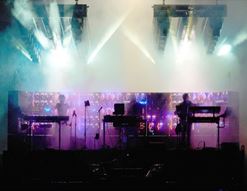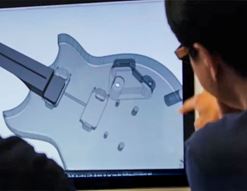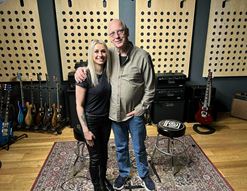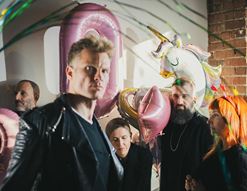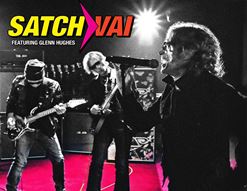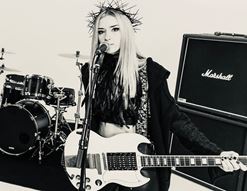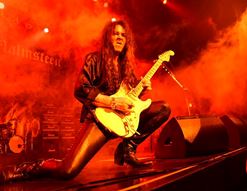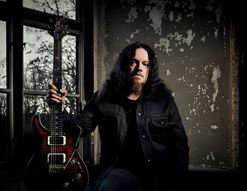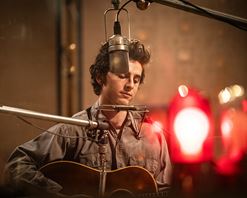Grammy award winners White Sun are making music that’s both timeless and perfect for right now.
The Californian three-piece, made up of singer/songwriter Gurujas Khalsa, multi-instrumentalist Adam Berry and founder/gong player Harijiwan Khalsa, have enjoyed ever-increasing success with their beautiful, evocative and otherworldly music. Since forming in 2015, the group – who combine ancient yogic spiritual texts and mantras with blissfully exotic soundscapes – have released four albums, countless EPs, topped the Billboard charts on more than one occasion and taken home the Grammy for Best New Age album in 2017.
In the past, this type of music would be referred to as ‘chill out’, but such a tag doesn’t do justice to the mellifluous, delicate and yet deep music that White Sun make. It spans centuries and geographical borders, with a focus very much on the interior landscapes of the listener, with a direct mission to heal and bring peace to those who listen, especially in these somewhat troubled times.
White Sun have recently released Sadhana, their fourth full length album, and we reached out to Gurujas to chat about writing, singing, the meaning of the mantras, and how important such music can be for people today.

(Photo: White Sun)
Speaking from her Los Angeles home via Zoom, Gurujuas proved to be a charming, charismatic and very funny conversationalist. Quick to laugh and an expert at explaining things simply, Gurujas was more than happy to talk about her process of writing, about the biological affect that certain sounds can have on us as humans, and lots more. She also shared some excellent tips about vocal practice that will no doubt prove invaluable to all singers out there!
Join us then, as Gurujas and I begin our in-depth talk...
White Sun Interview
guitarguitar: So, I guess we should start with the newest record, Sadhana. I wonder, is it correct to say that this particular record is designed more specifically to be listened to in one big continuous sequence, compared to your previous records?
Gurujas Khalsa: Yeah. So, there are many, many options for how you might want to use it, and that’s really up to each individual person, how they want to use the sounds. Certainly you’re right: one of the ways that you can use this new album is as a 62 minute meditation, where you’re sitting down, listening and chanting the whole time. Another way is you can play it while you sleep, so that’s something that we highly recommend. Another way is, maybe you have a favourite song, so you play that song and sing along for a minute or two, there’s really no wrong way to do it!
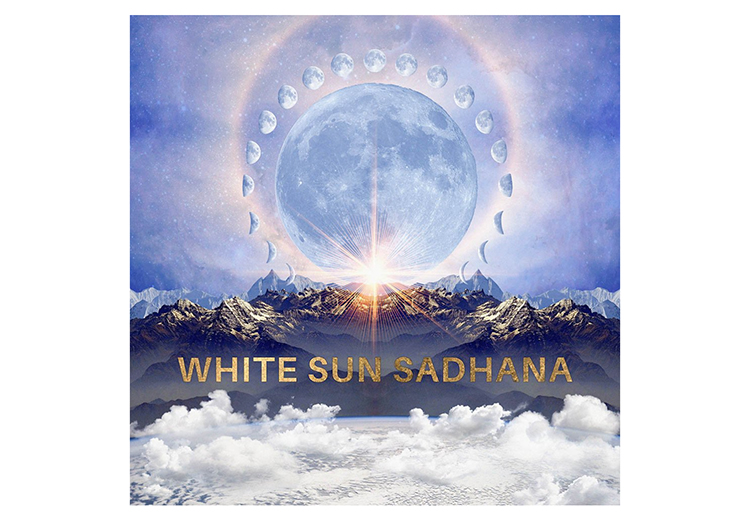
You know, the way we look at these sounds – I kind of call them ‘sounds’, they’re mantras – the way that we look at them is that they’re creating a high frequency. Everything on the planet and everything in the universe has a sound, and all these sounds have different frequencies, whether we can hear them or not. A low frequency is gonna produce a kind of low feeling, right? A negative feeling, and a high frequency is going to produce a positive feeling. So, when we look at the sounds in that way, there’s no incorrect way to use them.
GG: Okay, so that applies to all of White Sun’s music, I presume?
GK: Yeah.
GG: That’s touching on something I was going to go towards, actually. Generally speaking, with White Sun’s music, there are so many beautiful layers to each piece, but the ones that stand out the most for me are the vocals and then just the overall production quality. Are they the priorities?
GK: Yeah, that is kind of true. We do tend to mix the vocal a little hot, you know? We do that because we’ve just found that that’s what works. A lot of times, these mixes are not premeditated: there’s not a plan going in! (laughs) We kind of sit there, and now since the pandemic we’re not often in the same room together, but a song will just kind of communicate what it wants. The song will tell us, in a way, what needs to go higher and lower, the different plugins or the different hardware, and it just tends to work better when the vocals are mixed pretty high. Kind of above the mix is how we do it, and there’s no reason for that, except we’ve found that it works.
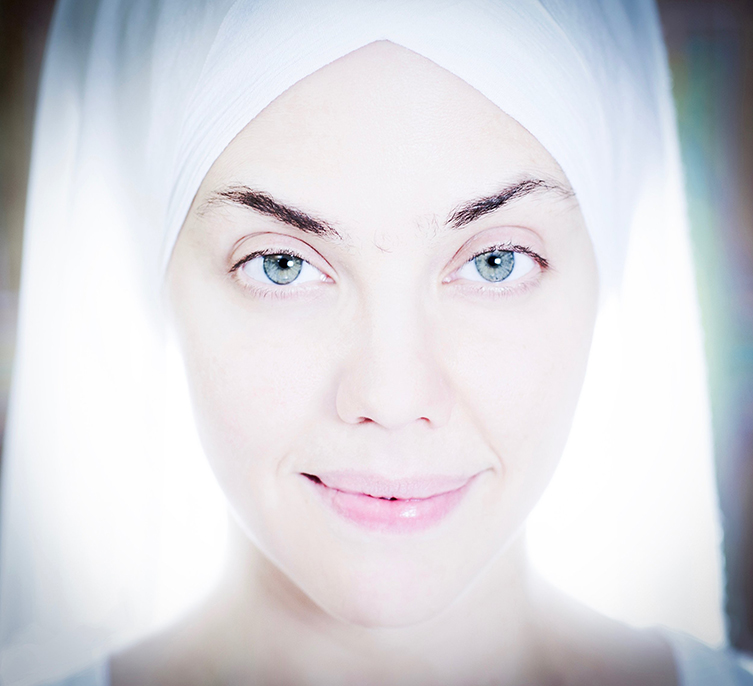
Gurujas (photo: Santosh)
GG: Yeah, it kind of dictates itself.
GK: Yeah, it dictates itself, I do feel like that. Of course, there’s sometimes a plan, but it’s rarely (laughs). I’ll have written a song, so I’ll have the melody and the words. I just kinda play and see what works. We’ve been really lucky, sometimes. We’ve worked with live players and so the live player will bring sort of a different life to the track as well, you know?
GG: Yeah, definitely. So the mantras themselves are of course thousands of years old, but a mantra on its own is not gonna get people to love your music. It has to be attached to a beautiful song. Do you start on a keyboard? Or with a vocal idea? How does that process begin for you?
"I want to help people find the tools they need to live the life that they want, despite what might be happening out there"
GK: Well, first of all, thank you so much for understanding that! (laughs) Because yes, it has to be a good song! I have to say, and I don’t know if this is correct or incorrect to say, but it’s how I feel: I would listen to mantra music and I thought so much of it sounded terrible! It was like, where is the production value? Where is the love? The craft, you know? I just felt like, ‘this isn’t right!’ (laughs) It’s supposed to sound better, why are they phoning it in, you know? Haha! So, thank you for understanding that it has to be a good song first! It has to have a decent melody, it has to have a rhythm that makes sense, the instrumentation should be well done. I think that people for a long time were phoning in the production for the mantras, and the mixes. So that’s very important to me, because otherwise it seems like a compromise.
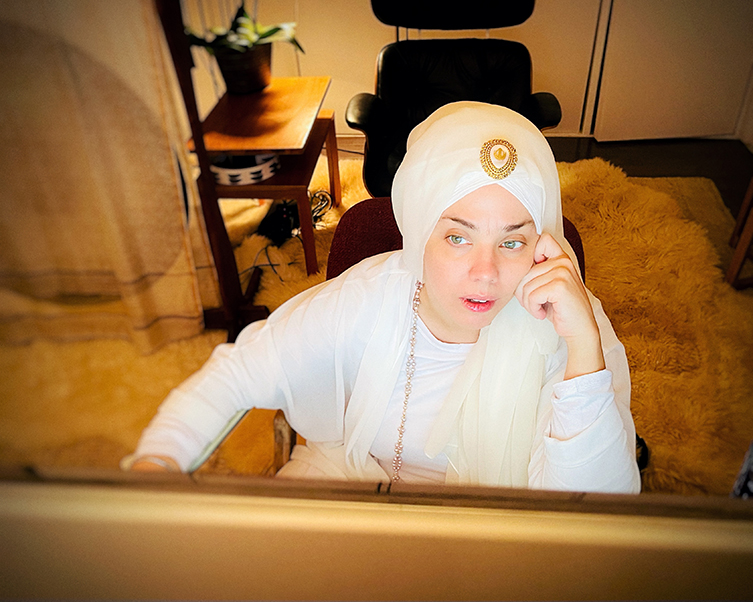
Gurujas at work (Photo: Harimander Khalsa)
How I’ll usually do it is sometimes I’ll just be going about my day and I’ll hear a melody and hum it into my voice memos. A few times - when it gets really fun - is when it wakes me up at night, haha! Oftentimes, it’ll just be me in front of the MIDI keyboard, usually using a piano sound – I like Keyscape (Spectrasonics top-end plugin – Ray) and I have Alicia’s Keys, too. I’ll just play with some chords and write it out that way. Recently, I’ve been writing in English, and my teacher and the founder of the band is incredible with words and poetry. I’m also really attracted to some of the Tibetan poems as I’m writing in English, just inspired by these different words that came from these practitioners. So yeah, piano is my go-to when I’m sketching.
GG: Cool! So then...is it Harijiwan you were referring to?
GK: Yes!
GG: So do you take, like, voice memo demos to him and Adam Berry, the other member? How does that become a White Sun song?
GK: Well it’s really evolved over the years. When we made our first album in 2015, I didn’t even know what a DAW was! (laughs) So, I relied very heavily on Adam to understand the technical aspect, but since then, slowly over time I’ve built my own studio and it’s fully equipped to be able to do everything that needs to be done. We’re still very much a team, and I couldn’t do it without Adam and Harijiwan.
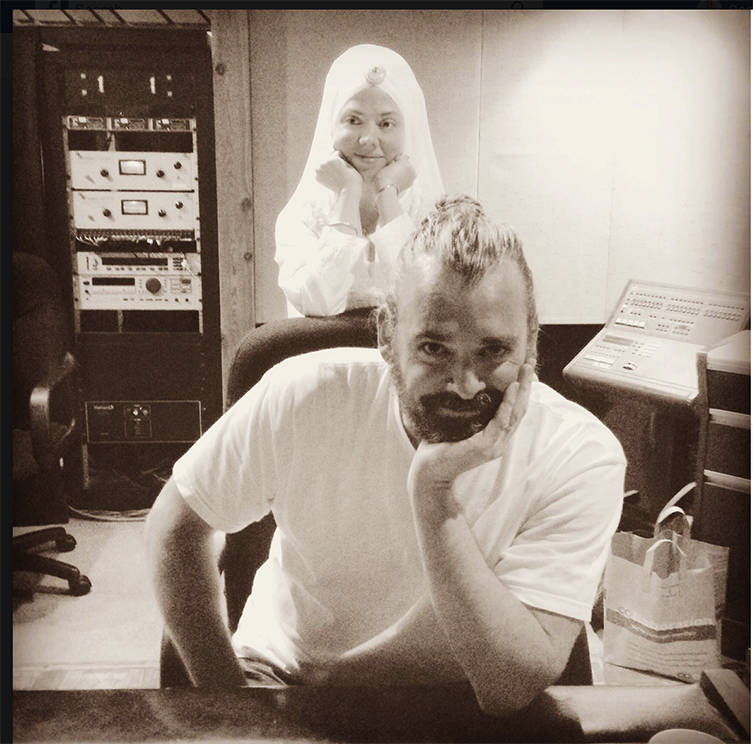
Adam and Gurujas in the Studio
GG: Fantastic! When you talk about building up a home studio, I saw a recent promo picture of White Sun and it looked like you had an Ableton Push controller in front of you?
GK: Yes, you did!
GG: I wonder, how do you incorporate that into the music?
GK: So, we started doing live performances every week during the pandemic and we didn’t have any live players for obvious reasons, haha! I had to be my own live player. Adam played the guitar and Harijiwan plays the gong, which is almost a whole other interview, what that is! So, I had to create all the other elements somehow in Push, so I learned Ableton and figured out how to program and trigger what I wanted to hear.
That process is evolving, but it meant that all the percussion, the bass, the piano, all the strings: everything is coming from the Push during a live performance. It was totally new for us and really exciting, actually! I loved it! We always played with live players and it created a whole new sound that I love. We’re all now working on the live album that’s gonna come from that process, that new approach to performing. That’s actually gonna be out quite soon: we’ve mastered like ten tracks already.
GG: Oh, cool! And so, were you taking the stems directly from your records to sort of put back in via Ableton?
GK: That’s something I debated heavily, whether to do that or not. I tried it with one song, with the original stems, and it wasn’t right. It sounded too unlikely, you know? I dunno, it didn’t sound real to my ears. There’s three of us in a room and I’m playing, like, very lush arrangements! (laughs) It didn’t work for me to do it like that, so what I would do is just create a really simple track, and make new tracks for each song. Keeping it super simple: a bass pad, a string pad, not much! A little percussion. It just felt more authentic to me.
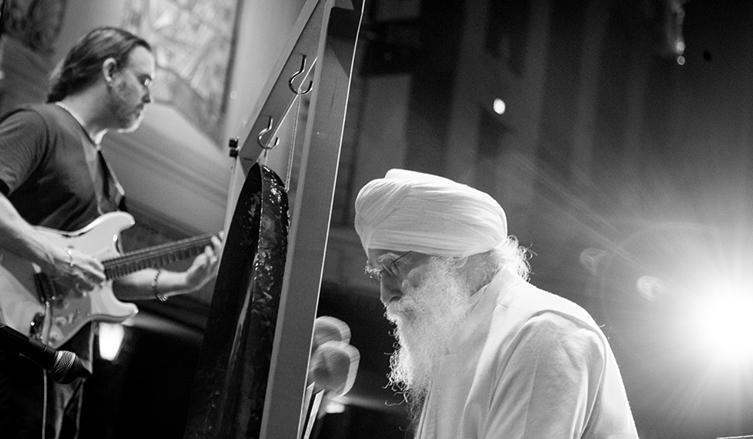
Adam and Hawijiwan performing live (Photo: Santosh)
GG: I quite agree! So, you mentioned that you were going to be writing in English, which is a new thing for White Sun, but previous to that, I wasn’t actually all that sure what language White Sun’s music is in! Is it some sort of Punjabi script?
GK: It is really confusing, and I have people ask me that all the time, it’s a very common question: what language is it in? You know, these mantras are between 5000 years old – some of them, like on the album you mentioned, there’s one that came from Patangili, who wrote the Yoga Sutras. So he gave that mantra 5000 years ago which predates Punjabi by a few thousand years. That was originally given in Sanskrit, I think. And then there are some mantras that are, like, 30,000 years old. I’m not even sure how they know that! (laughs) So, the Yogic way of understanding the sounds is that these are ancient languages that maybe were spoken, maybe were not spoken, but they were given to people as a way to transform consciousness. Mantra: man is ‘mind’, tra is ‘wave’, so mantra is ‘wave of the mind’. So, the sounds can help produce a positive wave in the mind, which helps create positive change in a person’s life.
The yogic way of understanding these things is, they are too old to be Punjabi, and then what happened is that – just for one example – over time, different groups of people or different cultures or different religions will take a portion of the yogic teaching and incorporate them into their specific world. I think that’s the idea of what happened in the Punjab, for instance, since we used that as an example. A lot of these mantras predate even the country, but there are some people who got a hold of the sounds and began to use them in whatever way they found worked.
So you’ll find these sounds in a lot of different traditions, religions, and even in academic circles. They are kind of sprinkled throughout, and I don’t think they have a specific language of origin, really.
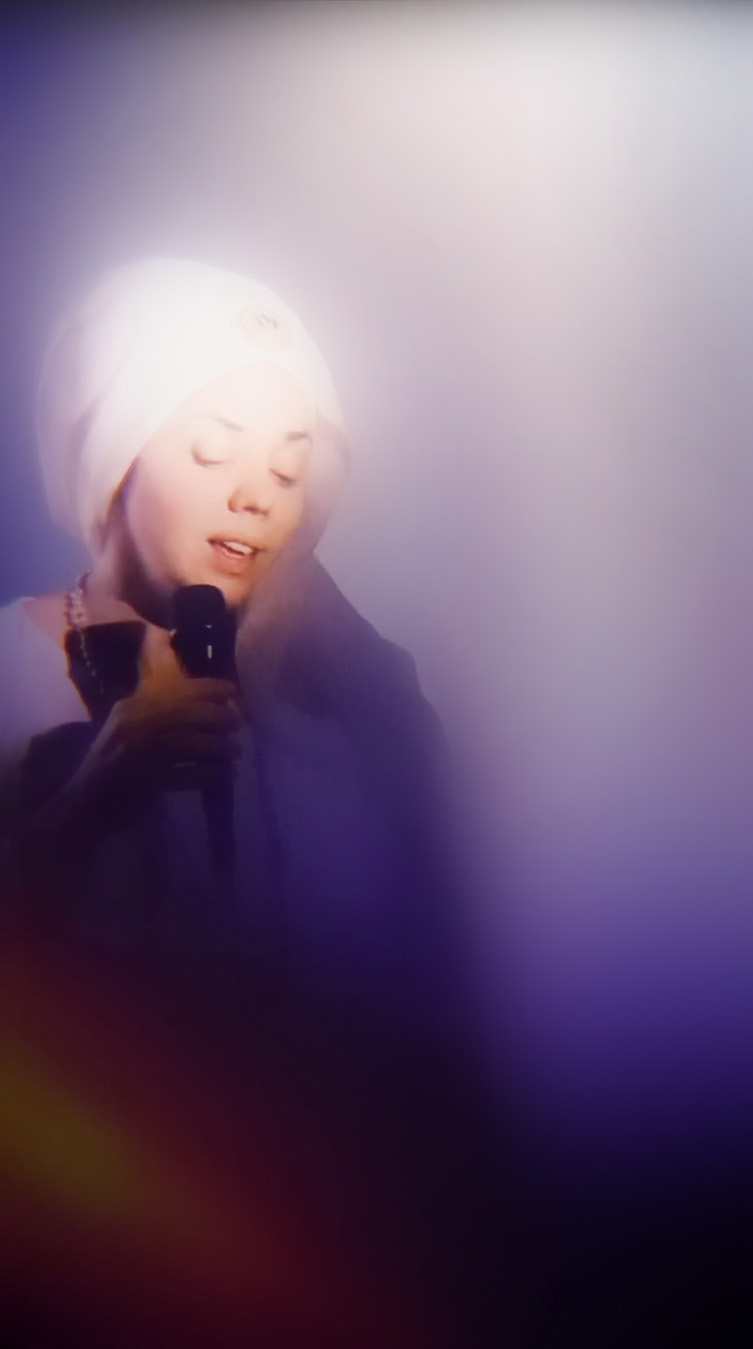
White Sun Livestream performance 2021 (Photo: Harimander Khalsa)
GG: Ah, I see! They’ve been passed around and down through the ages so much that the origins are a little misty.
GK: Yeah, it’s a bit ‘who knows what language they were originally in?’, the languages are too old. What we have is an alphabet that was given at some point in this long period of history, and this alphabet is phonetic, and it tells you how to pronounce the mantras. But it’s not specifically a language.
GG: That’s an excellent answer! I just assumed that it would all be Sanskrit or Punjabi, but it’s a lot older.
GK: Yeah, it’s a little too old to be able to say for sure, but we know it’s more than one language, and yeah, we know it doesn’t belong to any one culture or any one lineage.
GG: Okay, cool. That does touch on another thing I wanted to ask you about. As well as the translated meaning of any given mantra, is there also a phonetic power to the actual sound of the words themselves?
GK: Yeah, absolutely! We can even explain it biologically a lot of times, because these sounds will go in, and in the Yogic texts, they talk about the sounds and what the mantras do. They liken the roof of the mouth to the dome of the sky, which I always thought was a really cool way of looking at things. The macro and the micro, and how the universe is within us, I thought that was really neat. So, the mouth is the dome of the sky, and inside the mouth are meridian points just like there are stars and constellations in the sky.
"There's a lot that we don't know, but it still exists, and there's a lot that we don't hear, but it's still there"
So, this constellation has this energy, and there’s people who study the zodiac, astronomy and astrology, so many ways to look at the stars. They understand that each alignment has a different energy, a different quality to it or a different cycle to it, and it’s exactly the same as the mantras: you take the tongue and just like the scientists connect the constellations, the tongue connects the meridians in the roof of the mouth. Each sound has a different effect as the tongue sort of types in a computer code into the roof of the mouth. That stimulates the hypothalamus, and then the hypothalamus stimulates the pineal pituitary. What’s interesting is that we start to create peptides – we create peptides all the time, of course, and the glandular system distributes them to the cells of the body. So, when you put in these high-vibrational Yogic sounds, you’re putting in a completely different energy into your system. So the peptides are carrying the energy of whatever your tongue typed in or whatever sounds are going in. The peptides are distributed to the 30 trillion cells of the body and they dock onto the cell and they change even the nucleus.

Gurujas (Photo: Lorraine Young)
So, people are going ‘how do these things work?’ Well, that’s how they work, you know? (laughs) It’s a massive change that can occur in people, and people will tell me how their lives and their environments have changed since they began their mantra practice. We understand why the change would be so massive, because we look at it biologically as well as with the yogic sciences. I mean, there are so many stories I could share with you, Ray, but just one can illustrate the example:
There is this guy who didn’t have any money because he was a heroin addict, so he lost everything. Some people dabble: he was not a dabbler, he was a severe addict. He wanted to recover, so when I first met him, he had just stopped heroin that week. He was sleeping on someone’s couch. He just kept up with the mantras, and he kept up with his personal practice, whatever that was, and he got hold of a mantra that was for prosperity, because he needed money and he was having some issues! Now, it’s been a few years, but I can tell you this guy has his own business, the business is very successful, he travels the world, he is married, I mean the transformation has been huge! He goes, ‘It was a big transformation and it happened in stages. I first started chanting this mantra and someone gave me a bicycle. I was so grateful for this bicycle, now I can finally get around.’ And then he got a job at a grocery store, then the car comes, and it builds up over time. Now he’s very, very happy and his life is very prosperous.
He told me – this is not my interpretation – he told me this is because of the mantra he was chanting. So these things can be very, very powerful.
GG: That’s incredible! So, would that mean, then, that listening to a mantra is good for you, but actually learning it and repeating it is exponentially better for you than just passively listening?
GK: That is a really insightful question. So, that question was asked and the teacher said there are three different ways to do it. If you whisper the mantra, if you do it silently, or if you do it out loud, it’s all the same power. But, if you’re desperate, do it out loud! (laughs) But silently, or whispering or chanting is all the same. I think it’s really an effort-reward ratio, sometimes, you know? Like, how much you focus and how much you concentrate. I have mantras just playing in my house. You can buy a speaker on amazon for, like, 20 dollars and put in an SD card and it’ll just go 24/7. I think that’s one of the most powerful ways to use the mantras, because you don’t have to think about it. It takes no effort: you’re not trying to play it on your laptop or phone, it’s a speaker that you’re never gonna use for anything else! People say, ‘Which mantra should I play?’ Play whichever one you want! Which one do you like? (laughs) That’s the one you should play!
GG: Totally! That leads me on quite nicely: which mantra do I like? There’s one on White Sun III called Maha Kal Sat.
GK: Oh, good! I’m glad you like that one!
GG: It’s one of the most beautiful things I’ve ever heard.
GK: Thank you! Wow, that’s cool!
GG: So I’d love to know what that mantra says, but also, that’s one with lots of multitracked vocals, these extra angelic voices. Could you just talk to me a little about that track please?
GK: Yeah, well that one, as you heard, is quite lush in terms of instrumentation and vocal layering. So, Maha Kah Sat: they say that sometimes when these teachings are delivered, it’s in a minimum of seven layers. Seven layers of meaning, and so that particular mantra is ‘bring sight to the blind’, or ‘make the blind see’. Everybody should and would have their own interpretation of that but the way I interpret that is just: there’s a lot that we don’t know, but it still exists, and there’s a lot that we don’t hear but it’s still there. This sort of uncovers the veils. It allows us to see the unseen, hear the unheard, know the unknown and it reveals parts of the universe to us that were previously hidden.
GG: Wow.
GK: Yeah, I think it’s a powerful mantra.
GG: I picked a good one! You’re being very good at leading me to my next natural point today...
GK: I’m telling you, we were meant to talk together! (laughs)
GG: You teach kundalini yoga classes over in Los Angeles, and I wonder if White Sun’s music played a practical part in those? Like, when you’re composing, are you thinking about how the music might be used in your teachings?
GK: Yeah, sometimes! Sometimes we’ll have a specific need, like right now we have a need where we need people to learn more, faster! The world is in a very different place to where it was a couple of years ago and I think that the yogic knowledge is going to be really helpful for the population. We have that label ‘yogic’ – that’s the word we use to describe it – but it’s just a way of people enjoying their lives more.
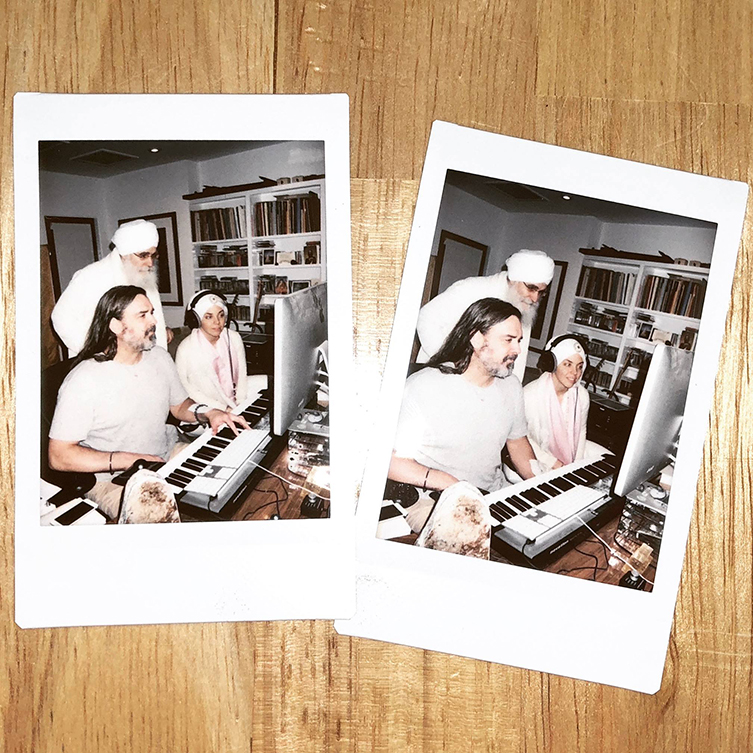
White Sun in the Studio (Photo: Fantosh)
There’s a lot of people who have experienced different levels of pain in the past couple of years, and to be honest, that’s not necessary. Even though the outside world might have big changes and big differences, low frequencies and different levels of kind of mind wars, these things are not necessary: it’s not necessary to live an incarnation like that. This is someone else’s movie, this is not my movie. I have my own movie that I’m directing, writing and casting (laughs) and I want it to be a good movie! I want it to be entertaining and fun! That’s how I see it, and I think that everyone has the power to do that. You should live your own movie, in your own timestream. The world might be creating a different movie, but that doesn’t mean that it has to be yours.
So I want to create this mantra. My teacher asked me to do it, and I wanna do it because it’ll help people find the tools they need to live the life that they want, despite what might be happening out there.
GG: That sounds brilliant, and much needed! I’ll mention the sad passing of your friend and fellow teacher Guru Jagat: was she an important factor in White Sun forming? Was she a catalyst for you guys?
GK: Guru Jagat is so amazing. She really was and is a huge supporter of ours. So we started White Sun around the same time she started the Ra Ma Institute, and her teacher was Harijiwan, my teacher is Harijiwan, and so we were sort of side by side in everything. She supported us so much. Sometimes she would request, like: ‘I wanna do a global meditation with a song’, and I was like, ‘Okay, I’ll make that song happen’. She had a lot of great strengths, and one of them was that she just enjoyed everything, you know? She just wanted to have a good time, and she did! She had a good time, no matter what was going on. She was only looking for the laugh!
GG: Yeah!
GK: Always looking to have fun! It was a great time, walking up the mountain side by side with her. She definitely supported us in every way she could.
GG: That’s great to hear. Now one thing: you have this beautiful singing voice with a lot of ability and skill. I wondered first of all who your singing influences were? I mean, I’m hearing Lisa Gerard and the Cocteau Twins but I might be miles off...
GK: Oh, cool!
GG: Oh, definitely! And I also wonder about how you warm up and look after your voice.
GK: Well, it’s so funny you should say Cocteau Twins, because it might be out just right now, let me see. We did Song to the Siren and we just distributed it.
GG: Oh wow, there you go!
GK: Yeah, that just got released, that’s so interesting that you hear Cocteau Twins. As for influences, there’s this one guy. I’ve not had a lot of vocal lessons or anything, you, but I always sang: choir or whatever, but I never did it professionally or thought that it was an option. But there’s one teacher, his name is Seth Riggs, and I saw him maybe three times, so not that much. Those were the only vocal lessons I ever had, and he is something very different on the planet Earth. I mean, I can say he’s a master vocal teacher, but there’s something else going on! There’s a wisdom in him that is rare to find and he’s carrying something special. He toured with Michael Jackson. It’s non-stop, the people that he’s taught, literally everyone: Barbara Streisand, Diana Ross and on and on!
I went to him with Harijiwan, only maybe three times, but still I’ll see his face sometimes when I’m singing. He taught something that is critical, if we’re talking about warmups and taking care of the voice. What he taught, and his students also teach, is there’s the larynx, right? It’s very, very simple, this teaching. You have a larynx, and you wanna make sure that you’re not forcing it down or forcing it up when you sing. Lose all support of the throat, so you’re not relying on the larynx to sing. You don’t have time, necessarily, to take deep breaths, so the belly comes out and that is your breath, right? So there is a diaphragmatic movement. And then just, speech-level singing I think is so important and he has a book out there which I recommend to anybody who is curious about this topic. I think it’s called Singing For the Stars.
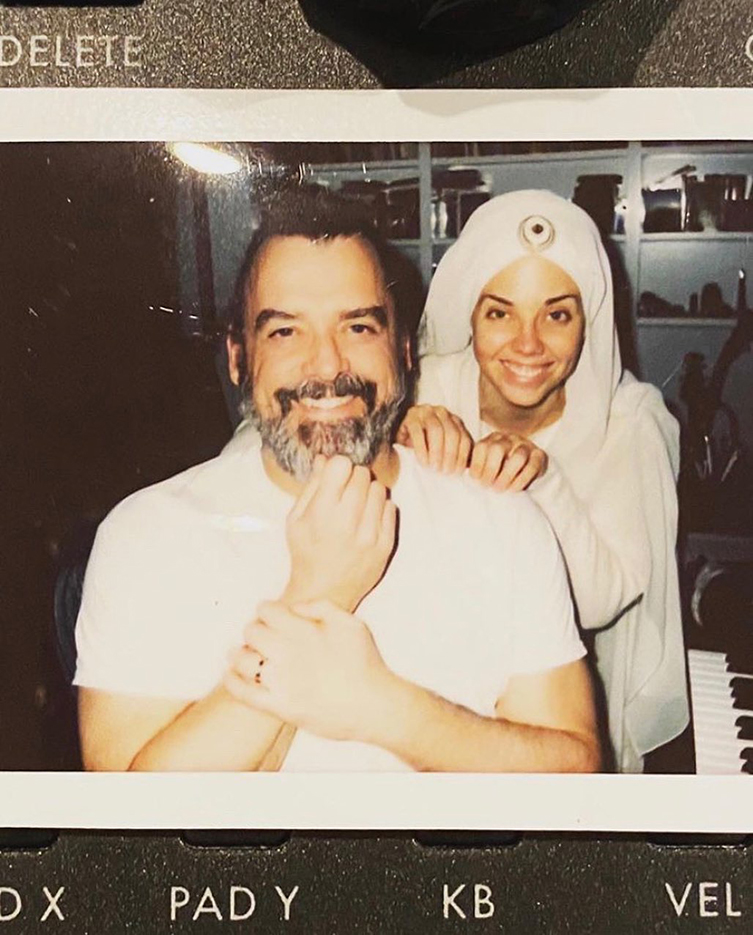
Adam and Gurujas in the Studio
But yeah, the larynx has to relax, and you have to get the hang of not forcing these muscles to go in any direction. They are muscles that need to be developed, but you certainly don’t want to force it. In his opinion, a lot of people who have had nodes or require surgery are just not signing correctly, and that’s why he has all of these massive artists that credit him with their careers! He teaches very correct singing in a unique way, so really, it’s as simple as ‘relax the larynx’.
GG: That’s so useful!
GK: I think it helps even to look at pictures of the larynx, so you know exactly where it is. It just takes some practice to get used to: we usually put so much emphasis on the throat, and he’s really saying that the emphasis is the throat being open without support, and the diaphragm doing the work.
GG: So when singers strain their throat muscles to be more ‘rock’ and aggressive sounding, it’s actually opposite to what they should be doing?
GK: Yeah, and what happens is, a lot of people start to compromise their very career! They require surgery, or they can’t tour, or have to tour shorter. Or, they can make an album but then they have to worry about their vocal health and can’t sing the songs too much. Seth Riggs calls it ‘speech-level singing’, which really says it all: it should require the same effort as talking. You don’t get tired! So, that’s been a really important teaching.
GG: That’s a great tip, really useful!
GK: Oh, good! I think it takes some practice, because people get used to yanking on the vocal chords or forcing the larynx, and when they try to change the bad habit, they don’t want to, because they haven’t learned how to master their sound in a way to sing the same way but healthy. It takes some practice to do it in a healthy way.
"Everything on the planet and everything in the universe has a sound, and all these sounds have different frequencies, whether we can hear them or not"
GG: A lot of singers think the unhealthy way is more emotional or authentic, but that’s more about learning and practising.
GK: Yeah, totally! I mean, you can belt, and you can scream, you can do it all, you just have to learn how to use your instrument differently.
GG: Yeah, exactly. So, just to tie things up: you mentioned already about the live record that’s currently being mastered.
GK: Uh-huh.
GG: Is that the next thing for White Sun? What are your plans for the near future?
GK: Yeah, so that’s the next thing, this live album. It’s actually all cover songs. We’re writing some songs in English, and of course some mantra songs, and we performed it all, a big mix of everything. On this album, we decided to just put on cover songs. It’s kind of like travelling through these memory corridors of the past, you know? You have these associations with these songs, like Nature Boy, we covered. People have these emotional and historical associations with certain songs and we just wanted to put our take on them whilst paying homage to the original artists and just kind of create a new energy around the song. Maybe even open up a different energy inside the memory corridor, so it’s an exciting cool new project, you know?
GG: Sounds great!
GK: Thank you! And we’re scheduled to go on tour next year, but you just never know...you just never know! (laughs)
GG: Yeah, that’s been the final response to all interviews of the last two years, pretty much! ‘Yeah, there’s a tour booked, and we’ll see if it happens’.
GK: Yeah, yeah, exactly!
GG: I hope it does. Thank you Gurujas, it’s been a delight!
GK: Thank you Ray!
Gurujas shared lots with us, and put it all across in a very easy to handle way. We’re grateful, and found the conversation to be most enjoyable and stimulating.
For those looking to relax and dive deep within their own consciousness, White Sun are tailor-made for your needs. Anyone looking to pretty up their day with gorgeous music will find this music perfect for that too, as will those looking to find an oasis of calm within a turbulent world.
You can find White Sun’s music wherever you stream from, and keep an eye on the official White Sun website for more details of new music, tours and all the rest.
We’d like to thank Gurujas for giving up her morning for us, and sharing so many pieces of wisdom and insight, as well as just being friendly and fun to talk to! We’d also like to thank Harimander Khlasa for all of his help in setting us up.
Thanks, as always, to yourself for clicking through and reading this interview! We hope you enjoyed it, and we’ll humbly point you towards our guitarguitar interviews page for over a hundred more from the last four years. There will be more in the near future, so we’ll see you soon!

